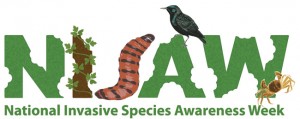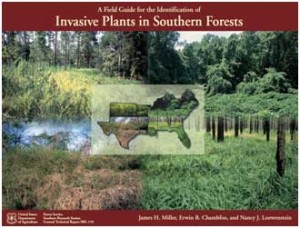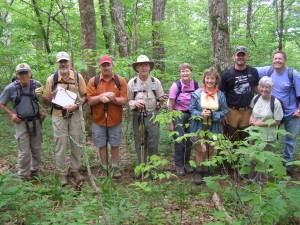Each year, the 1st of March brings a new energy. Perhaps it’s the onset of spring, the budding trees, or the touch of warmer weather. This time of year, all living creatures, animal and plant alike, are beginning to shed their winter layers and increase their activity levels. A quick walk through the woods may yield the earliest spring blooms, foraging birds, and your favorite trees may be popping out leaf and flower buds. But as new shoots of native plants emerge, so do those of invasive ones.
Non-native invasive floras, plants which have been introduced from other parts of the world and which are capable of capitalizing on as much open habitat as possible, choke out our native biodiversity. They grow and reproduce rapidly (most produce viable seed at an earlier age than native species), and are poor sources of nutrition for our native fauna. In southern forests, non-native invasive floras are one of the biggest and most serious threats to ecological health.
So as the month of March brings better weather, and as plants and animals, native and non-native alike, begin or renew their life cycles, challenges are brought forth as to the preservation of our natural heritage. In the United States, those challenges are met in the first week of March when National Invasive Species Awareness Week (NISAW) kicks off. NISAW is a national effort to educate people about non-native invasive flora and fauna across the United States. These species range from Princesstree to fire ants to the Brazilian green porcelain crab, with each species having successfully invaded its respective American ecosystem. Someone has to do something, right?

Right! The goal of National Invasive Species Awareness Week is to educate, to shed light on the severity of the threat posed by non-native invasive species in America. An abundance of resources are available to those who want to learn more. For example, the most recent version of James H. Miller’s Field Guide for the Identification of Invasive Plants in Southern Forests was published at the close of 2010. It is available to the public, and all you have to do is contact the US Forest Service Southern Research Station here in Asheville and let them know you’d like a copy. There’s also a follow-up publication, A Management Guide for Invasive Plants in Southern Forests (Miller, 2010), which prescribes treatment methods for each respective invasive plant. These books can help you get rid of invasives in your own yard!

Here at Equinox we work closely with invasive-exotic plant species. We are a proud partner in the Southern Appalachian Cooperative Weed Management Partnership (SACWMP); Equinox works with the Western North CarolinaAlliance (WNCA) and the Appalachian Trail Conservancy (ATC) to coordinate volunteers to inventory and treat invasive plant species along sections of the Appalachian Trail. Funding for the partnership is sourced through grant opportunities made available by the National Forest Foundation (NFF) and the National Fish and Wildlife Foundation (NFWF). Many of the targeted sections are classified by the NC Natural Heritage Program as Significant Natural Heritage Areas (SNHAs), meaning they contain elements or communities of plant species considered to be important or threatened. By controlling the spread and development of invasive species in these areas, we are ensuring that those special native plants (and common ones as well) have a chance to survive and multiply.
It is important to educate yourself about invasive-exotic species. Once you begin to understand how their presence affects our natural world, you can see how just one person can make a difference. When many passionate individuals unite, collaborative efforts begin to produce greater results. Partnerships are born, boundaries are protected, and natural communities are preserved. This week, we challenge you to make a serious effort to learn, to get involved in the fight against alien invasives. Check out the NISAW website (www.nisaw.org) for more information, and if you’re inspired to do good work, go to www.sacwmp.org and join the SACWMP mailing list or register to volunteer in the future. Take the new energy that March brings and put it to work!
Owen Carson – Field Technician

